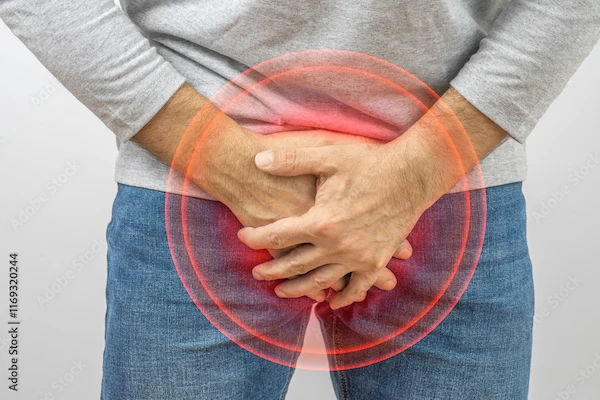Understanding Urinary Incontinence: Types, Causes, Symptoms and Treatment Options
Learn about urinary incontinence, its types, causes, symptoms, and treatment options. Discover how lifestyle changes, medications, and medical interventions can help manage bladder control effectively.

Written by Dr.Sonia Bhatt
Last updated on 3rd Jul, 2025

Introduction
Urinary incontinence is a condition that many people experience but often feel embarrassed or uncomfortable talking about. While urinary incontinence is more common among older adults, it can affect people of all ages and genders. It is important to know that urinary incontinence is a medical condition that can be treated and managed, and with the right approach, those living with it can regain control and improve their quality of life.
This article will guide you through the basics of urinary incontinence, including its types, causes, symptoms, and the available treatment options. Additionally, we will explore lifestyle changes and self-care strategies that can help improve bladder health and reduce the impact of incontinence.
What Is Urinary Incontinence?
Urinary incontinence is the involuntary loss of bladder control, resulting in the accidental leakage of urine. The severity of this condition can vary significantly, from occasional leakage when sneezing or laughing to more frequent and persistent instances of incontinence. Although it is a prevalent condition, many individuals feel embarrassed or ashamed to discuss it, leading to underreporting.
The bladder functions as a muscular organ that stores urine until it is ready to be expelled. This process can be disrupted by various physical, neurological, or emotional factors, leading to urinary incontinence.
Types of Urinary Incontinence
Urinary incontinence is categorised into several different types, depending on the cause and nature of the leakage. The most common types are:
Stress Incontinence: Stress incontinence occurs when physical activities such as coughing, sneezing, laughing, exercising, or lifting heavy objects put pressure on the bladder, causing urine leakage. This type of incontinence is more common in women, especially after childbirth or menopause, due to weakened pelvic floor muscles. However, men can also experience stress incontinence after prostate surgery.
Urge Incontinence (Overactive Bladder): Urge incontinence, also known as overactive bladder (OAB), involves a sudden, intense urge to urinate, followed by the inability to control the bladder. It can occur even if the bladder is not full, leading to frequent trips to the bathroom, sometimes with little warning. This type of incontinence is common in older adults and can be caused by bladder muscle overactivity.
Overflow Incontinence: Overflow incontinence happens when the bladder is unable to empty fully, leading to leakage due to the buildup of urine. This type of incontinence is often associated with bladder obstruction, such as from an enlarged prostate or certain neurological conditions. It can result in a constant dribbling of urine, especially at night.
Functional Incontinence: Functional incontinence is not caused by bladder or urinary tract problems but by physical or mental conditions that impair a person’s ability to reach the bathroom in time. Conditions like arthritis, dementia, or mobility issues can make it difficult for individuals to get to the bathroom before an accident happens.
Mixed Incontinence: As the name suggests, mixed incontinence is a combination of more than one type of incontinence, often stress incontinence and urge incontinence. People with mixed incontinence experience symptoms of both stress and urge incontinence, requiring a multi-faceted approach to treatment.
Causes of Urinary Incontinence
Urinary incontinence can be triggered by a variety of factors, which may be temporary or chronic. Some common causes include:
Weak pelvic floor muscles: Childbirth, ageing, and hormonal changes can weaken the muscles that support the bladder and urethra, leading to stress incontinence.
Neurological conditions: Conditions like multiple sclerosis, Parkinson’s disease, or stroke can affect the nerves that control bladder function, leading to urge or overflow incontinence.
Prostate problems: In men, an enlarged prostate or prostate surgery can cause urinary retention or stress incontinence.
Urinary tract infections (UTIs): UTIs can irritate the bladder and cause temporary incontinence symptoms, such as urgency and frequency.
Medications: Certain medications, especially diuretics, sedatives, and some antidepressants, can contribute to urinary incontinence as a side effect.
Obesity: Carrying excess weight puts additional pressure on the bladder, which may contribute to both stress and urge incontinence.
Hormonal changes: In women, changes in estrogen levels, especially after menopause, can weaken the pelvic floor muscles and affect bladder control.
Bladder conditions: Bladder stones, infections, or tumours can cause incontinence by irritating the bladder or obstructing urine flow.
Symptoms of Urinary Incontinence
The primary symptom of urinary incontinence is the involuntary leakage of urine. However, other symptoms may include:
Frequent need to urinate
Urgent need to urinate, often with little warning
Difficulty controlling urination
Feeling as though the bladder is never fully empty
Waking up frequently at night to urinate (nocturia)
Diagnosis and Evaluation
Accurate diagnosis is crucial for developing an effective treatment plan for urinary incontinence. The diagnostic process typically involves:
Medical History: A detailed medical history, including information about symptoms, lifestyle factors, and underlying health conditions, helps identify potential causes.
Physical Examination: A physical examination may involve assessing the pelvic floor muscles, checking for signs of infection, and evaluating overall health.
Urinalysis: A urine sample is tested for signs of infection, blood, or other abnormalities.
Bladder Diary: Keeping a bladder diary to track fluid intake, urination frequency, and instances of incontinence can provide valuable insights.
Postvoid Residual Measurement: This test measures the amount of urine remaining in the bladder after urination, helping to identify overflow incontinence.
Urodynamic Testing: Urodynamic tests assess bladder function and the efficiency of the urinary system, providing detailed information about the underlying causes of incontinence.
Imaging Tests: Ultrasounds or other imaging tests may be used to visualise the bladder and urinary tract.
Treatment Options
The treatment of urinary incontinence depends on the type and severity of the condition, as well as the underlying cause. Here are some common treatment options:
1. Lifestyle and Behavioral Changes
Simple lifestyle adjustments and targeted exercises can significantly improve bladder control and reduce urinary incontinence.
Pelvic Floor Exercises: Also known as Kegel exercises, these involve tightening and relaxing the pelvic floor muscles to strengthen them and improve bladder control.
Bladder Training: This technique involves gradually increasing the time between bathroom visits to train the bladder to hold urine for longer periods.
Dietary Modifications: Reducing the intake of bladder irritants such as caffeine, alcohol, and spicy foods can help manage symptoms.
Weight Management: Maintaining a healthy weight can reduce pressure on the bladder and improve incontinence.
2. Medications
Several medications can help manage urinary incontinence by targeting different aspects of bladder function:
Anticholinergics: These medications reduce bladder muscle spasms and are commonly used to treat urge incontinence.
Mirabegron: This medication relaxes the bladder muscles, increasing bladder capacity and reducing the urgency to urinate.
Topical Estrogen: In postmenopausal women, topical estrogen can help strengthen the tissues of the urinary tract and reduce incontinence.
Alpha-Blockers: These medications relax the muscles of the prostate and bladder neck, making it easier to empty the bladder in men with an enlarged prostate.
3. Medical Devices
For individuals who need additional support in managing urinary incontinence, medical devices offer practical solutions.
Urethral Inserts: These small, disposable devices can be inserted into the urethra to prevent urine leakage during physical activities.
Pessary: A pessary is a device inserted into the vagina to support the bladder and reduce stress incontinence.
Catheters: In cases of overflow incontinence, catheters can be used to empty the bladder regularly.
4. Surgical Interventions
For severe cases of urinary incontinence that do not respond to other treatments, surgical options may be considered:
Sling Procedures: A sling made of synthetic material or tissue is placed under the urethra to support it and prevent leakage.
Bladder Neck Suspension: This procedure involves lifting and securing the bladder neck and urethra to improve support.
Artificial Urinary Sphincter: An implanted device that mimics the function of a healthy urinary sphincter, providing control over urine flow.
Botox Injections: Botox can be injected into the bladder muscles to reduce spasms and improve bladder control.
When to See a Doctor
If you experience any of the following symptoms, it's essential to see a doctor:
Sudden or severe incontinence
Difficulty urinating or a weak urine stream
Painful urination or blood in the urine
Incontinence that interferes with your daily life
Conclusion
Urinary incontinence is a common but often underreported condition that affects many individuals. The good news is that effective treatment options are available, ranging from lifestyle changes and pelvic floor exercises to medications and surgical interventions. By understanding the causes, symptoms, and available treatments, you can take charge of your health and regain control of your bladder. If you or someone you know is experiencing urinary incontinence, seek support from a healthcare provider who can help diagnose the cause of your incontinence and work with you to create a personalised treatment plan.
Consult Top Urologists
Consult Top Urologists

Dr. Sateesh Marriwada
Urologist
17 Years • MBBS, MS (General Surgery), Mch ( Genito Urinary Surgery)
Visakhapatnam
Apollo 24|7 Clinic - Andhra Pradesh, Visakhapatnam

Dr Tharaka Mourya Nutulapati
Urologist
7 Years • MBBS, MS (General Surgery), Mch ( Urology)
Visakhapatnam
Apollo 24|7 Clinic - Andhra Pradesh, Visakhapatnam

Dr. Sandeep Maheswara Reddy Kallam
Urologist
6 Years • MBBS, MS (General Surgery), M Ch (Genito-Urinary Surgery), Post Doctoral Fellowship in Uro-Surgical Oncology
Visakhapatnam
Dr. SANDEEP MAHESWARA REDDY K _- best Urologist in visakhapatnam, Visakhapatnam
(225+ Patients)

Dr. Prabir Basu
Urologist
19 Years • MBBS, MS General Surgery, DNB Genito-Urinary Surgery
Jodhpur Park
Dr. Prabir Basu urology clinic, Jodhpur Park
(125+ Patients)
Dr. Mohammed Rehan Khan
Urologist
8 Years • MBBS, MS (General Surgery), Mch (Urology)
Barasat
Diab-Eat-Ease, Barasat